Stygimys is an extinct mammal genus from the Upper Cretaceous and Paleocene of North America. It was a member of the extinct order Multituberculata within the suborder Cimolodonta, family Eucosmodontidae.

Chilognatha is a subclass of the class Diplopoda, which includes the vast majority of extant millipede, about 12,000 species.
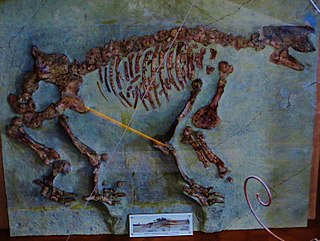
Chalicotherium is a genus of extinct odd-toed ungulates of the order Perissodactyla and family Chalicotheriidae, found in Europe, Africa, Asia, and North America from the Late Oligocene to Early Pliocene, 28.4–3.6 million years ago, existing for approximately 24.8 million years .

Biarmosuchia is an extinct clade of non-mammalian synapsids from the Permian. Biarmosuchians are the most basal group of the therapsids. They were moderately-sized, lightly-built carnivores, intermediate in form between basal sphenacodont "pelycosaurs" and more advanced therapsids. Biarmosuchians were rare components of Permian ecosystems, and the majority of species belong to the clade Burnetiamorpha, which are characterized by elaborate cranial ornamentation.
La Venta is a fossil locality located in the modern departments of Tolima and Huila in Colombia. This site is one of the richest Neogene fossil assemblages in South America and represents the best-known Cenozoic fossil site outside of Argentina. It provides a glimpse of what life in the region was like before the main wave of the Great American Interchange.
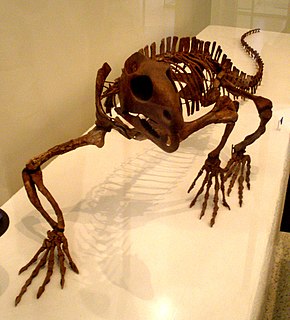
Trilophosaurus is a lizard-like trilophosaurid allokotosaur known from the Late Triassic of North America. It was a herbivore up to 2.5 m long. It had a short, unusually heavily built skull, equipped with massive, broad flattened cheek teeth with sharp shearing surfaces for cutting up tough plant material. Teeth are absent from the premaxilla and front of the lower jaw, which in life were probably equipped with a horny beak.
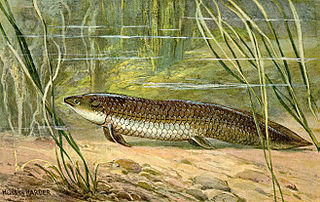
Ceratodus was a wide-ranging genus of extinct lungfish. Fossil evidence dates back to the Early Triassic. A wide range of fossil species from different time periods have been found around the world in places such as the United States, Argentina, Greenland, England, Germany, Egypt, Madagascar, China, and Australia. Ceratodus is believed to have become extinct sometime around the beginning of the Eocene Epoch. The closest living relative of Ceratodus is thought to be the Queensland lungfish, Neoceratodus forsteri, which means "new Ceratodus" in Greek.
Paleontology or palaeontology is the study of prehistoric life forms on Earth through the examination of plant and animal fossils. This includes the study of body fossils, tracks (ichnites), burrows, cast-off parts, fossilised feces (coprolites), palynomorphs and chemical residues. Because humans have encountered fossils for millennia, paleontology has a long history both before and after becoming formalized as a science. This article records significant discoveries and events related to paleontology that occurred or were published in the year 1997.
Paleontology or palaeontology is the study of prehistoric life forms on Earth through the examination of plant and animal fossils. This includes the study of body fossils, tracks (ichnites), burrows, cast-off parts, fossilised feces (coprolites), palynomorphs and chemical residues. Because humans have encountered fossils for millennia, paleontology has a long history both before and after becoming formalized as a science. This article records significant discoveries and events related to paleontology that occurred or were published in the year 2000.
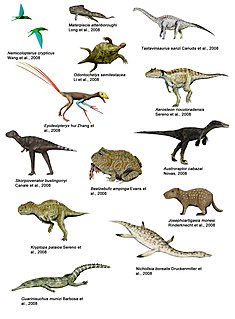
Paleontology or palaeontology is the study of prehistoric life forms on Earth through the examination of plant and animal fossils. This includes the study of body fossils, tracks (ichnites), burrows, cast-off parts, fossilised feces (coprolites), palynomorphs and chemical residues. Because humans have encountered fossils for millennia, paleontology has a long history both before and after becoming formalized as a science. This article records significant discoveries and events related to paleontology that occurred or were published in the year 2008.

Cyclotosaurus is an extinct genus of temnospondyl within the family Mastodonsauridae. It was of great size for an amphibian, reaching 3–4.3 m (9.8–14.1 ft) in length with an elongated 70 cm (28 in) skull.
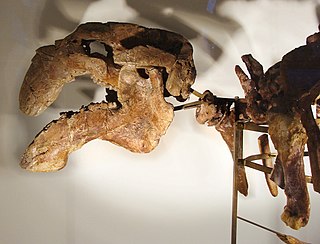
Eotheroides is an extinct genus of Eocene sirenian. It is an early member of the family Dugongidae, which includes the extant dugong. Fossils have been found from Egypt, India, and Madagascar. Eotheroides was first described by Richard Owen in 1875 under the name Eotherium, which was replaced by the current name in 1899.
Trilobites are used as index fossils to subdivide the Cambrian period. Assemblages of trilobites define trilobite zones. The Olenellus-zone has traditionally marked the top of the Lower Cambrian, and is followed by the Eokochaspis zone.

Isalorhynchus is an extinct genus of hyperodapedontine rhynchosaur from the late Triassic period of Toliara Province, southwestern Madagascar. It is known from the holotype MDE-R18, a nearly complete maxilla and from other specimens from the same locality, Malio River area. It was found in the Makay Formation of the Morondava Basin. It was first named by Eric Buffetaut in 1983 and the type species is Isalorhynchus genovefae. The majority of Isalorhynchus specimens are isolated jaw bones, but two nearly complete skeletons were found in 1998. Langer et al., 2000 concluded that Isalorhynchus is a synonym of Hyperodepedon and referred it to a new species of Hyperodepedon. Whatley, 2005 retained this genus as valid with a description of new materials in her PhD thesis. Montefeltro et al., 2010 and Langer et al., 2010 accepted Isalorhynchus as valid genus.

Triceratopsini is a tribe of herbivorous chasmosaurine dinosaurs that lived between the late Campanian to the late Maastrichtian stages of the Cretaceous period, between 74.73 and 66 million years ago. Fossils of these animals have been found in western North America, in particular West Canada, Western and Midwestern United States, which was once part of the ancient continent of Laramidia. The tribe was named by Nicholas R. Longrich in 2011 for the description of Titanoceratops, which he defined as "all species closer to Triceratops horridus than to Anchiceratops ornatus or Arrhinoceratops brachyops". Triceratopsins were the largest of the chasmosaurines; suggesting that gigantism had evolved in the Ceratopsidae once. In addition there is an evolutionary trend in the solidification of the frills, the most extreme being in Triceratops.

Paleontology or palaeontology is the study of prehistoric life forms on Earth through the examination of plant and animal fossils. This includes the study of body fossils, tracks (ichnites), burrows, cast-off parts, fossilised feces (coprolites), palynomorphs and chemical residues. Because humans have encountered fossils for millennia, paleontology has a long history both before and after becoming formalized as a science. This article records significant discoveries and events related to paleontology that occurred or were published in the year 2013.

Richard Lawrence Hoffman was an American zoologist known as an international expert on millipedes, and a leading authority on the natural history of Virginia and the Appalachian Mountains. He was a biology professor at Virginia's Radford College for almost thirty years, and curator of invertebrates at the Virginia Museum of Natural History for another twenty years. He co-founded the Virginia Natural History Society, described over 400 species of millipedes, and produced more than 480 scientific publications. He is commemorated in the scientific and/or common names of over 30 animal species, including the valley and ridge salamander and Hoffman's dwarf centipede.

Xyloiuloidea is an extinct superfamily of millipedes that existed from the Lower Devonian through the Upper Pennsylvanian period in Europe and North America.
Neurankylus is an extinct genus of turtles in the Testudines order that lived between 112 and 61 million years ago in Canada and the United States. It was originally placed within the monotypic family Neurankylidae, but it has since been placed in the Neurankylinae, alongside Trinitichelys. The type species, Neurankylus eximius, was described by Lawrence Lambe in 1902. The species N. lithographicus was discovered in the Milk River Formation (Canada), alongside the holotype of the pachycephalosaurid dinosaur Acrotholus audeti.
Nancy B. Simmons is an American zoologist, mammalogist, professor, and author. Specializing in bats, Simmons has conducted extensive research on the morphology and evolutionary history of numerous bat species. She is also the curator-in-charge of the Department of Mammalogy at the American Museum of Natural History and a professor at the Richard Gilder Graduate School.













